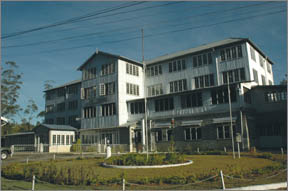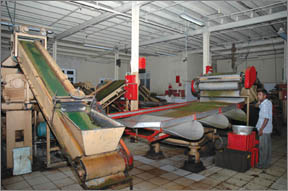Tasting the 'good' of Lankan tea
Tea and the TRI in Talawakelle a great pride :
by Chanuka Mannapperuma
|

Tea testing
|
|

St. Coombs Factory View
|
The agricultural sector contributed 19.4% to the country's annual
gross domestic product GDP in last decade. Tea is one of the main
foreign exchange earners in this country.
Sri Lanka, as the third largest tea producer in the world has an
approximate share of 10% of the tea global market, with an annual
production of nearly 300 million kg made tea. Currently, Sri Lanka is
also the largest exporter of tea in the world, exporting 280 million kg
annually about 22% of the world's exports. About 60% of the tea is
exported in bulk form and 40% is exported in the value-added form.
When we talk about tea we cannot forget the Tea Research Institute
(TRI) in Talawakelle. The function of the TRI is to raise productivity
of tea small holdings, estates and factories through scientific
research. And continue to recommend.
The fully equipped TRI Building was established in 1926 and presently
St. Coombs is the main estate under the TRI. It consists of Advisory and
extension service, Agronomy, Agricultural Economics, Biochemistry,
Entomology, plant breeding, plant pathology, plant physiology and
propagation, soil and plant nutrition, technology, Service Units.
|

Tea varieties |
Every one would like to know how we get good quality tea. Head
Factory Officer at St. Coombs factory, E.M. Dayarathne explained the
process of 'making tea'.
The botanical term for the tea plant is Camellia Sinensis. From the
pluckers it comes directly to the withering section, which does the
drying system. There we have to wither around 6 hours.
The TRI factory consists of 10 withering tracks. Each track will
carry up to 1000kg. From this method 44% of water is extracted out of
the tea leaves. It is maintained properly to ensure quality and is
tested. He added that they make quality tea with experience.
From this point onwards it comes to the rolling machine, which does
the pre conditioning producing enzymes. After that the workers transfer
the tea leaves to the Roteven machine which crakes the leaf into pieces.
Thereafter, the tea pieces flow to another huge tray which does
sifting. Then the quality tea goes to another tray and the over stock is
moved to another place, where it is used as fertilizer for tea crops
later.
Finally it is put on the electronic oven which does further drying
between 190 F-200 F and if it over flows will have to be used as
garbage." Finally tea samples are taken to the testing division and
after testing, it is approved and made as quality tea.
He said, Sri Lanka has a good demand for our tea from India,
Pakistan, Russia, Middle-east, England and Japan.
|

Machine
Pix. Sunil Samarasinghe |
He said "in this factory there were seven varieties, BOP, PEOKOE,
BOPF, DUST 01, FANNING, BM and DUST of different flavours. Tea is the
least expensive beverage besides to water. Tea is a calorie free natural
beverage without added preservatives or colouring agents. Therefore, it
will not only refresh and revive but also help to lead a healthy life.
Up to now TRI has introduced tea, ice tea and tea wine which is of very
good taste."
Explaining further about tea cultivation, Jayantha Hulangamuwa
Superintendent St. Coombs Estate said, Our estate has 238 hectares and
we have 720 workers. In our factory we have only five workers among
these.
Harvesting of tea is considered one of the most important factors
which affect productivity and quality of tea. Presently, many tea
plantations are facing difficulties in adopting proper tea harvesting
policies due to shortage of workers.
Consequently, the productivity and quality of made tea has been
greatly reduced. Additional cost of harvesting has also escalated due to
the increase in daily wages and poor plucker intake.
Therefore, mechanical harvesting is introduced as an alternative to
manual harvesting to reduce the cost of harvesting a good quality of
harvested shoots.
Different types of mechanical harvesters, manual shears and motorized
machines, have been used on trial basis to enhance plucker intake,
maintain proper harvesting rounds and reduce plucking cost.
However, such efforts were not successful due to various reasons such
as crop losses owing to non-selective harvesting, poor manoeuvring
ability, high cost of machine maintenance and negative attitude of users
towards such equipment. Nevertheless, many of these disadvantages and
problems has been removed by introducing the TRI selective Tea harvest.
[email protected] |
